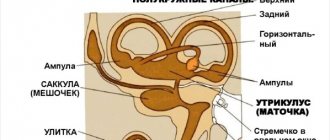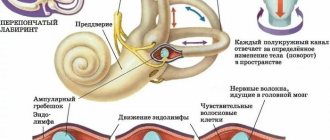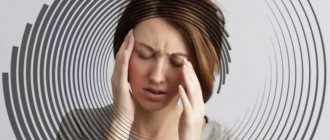Headache occurs in the form of episodic attacks or worries the patient constantly. Attacks of headaches may be accompanied by pain in the eyes, ripples before the eyes, and the sensation of flies flying. These are symptoms of serious diseases that doctors at the Yusupov Hospital identify using modern instrumental and laboratory research methods.
Neurologists, therapists, and oncologists treat patients. Professors and doctors of the highest category at a meeting of the expert council discuss all cases of severe headaches and eye pain that are not amenable to drug therapy. Leading cephalgologists (specialists in the field of headache treatment) collectively develop further tactics for patient management.
Causes
The most common reasons:
- Glaucoma. This disease is associated with increased intraocular pressure. The development of pathology is accompanied by pressing pain in the eye. The list of typical symptoms also includes fog before the eyes, a sharp decrease in visual acuity, and sometimes nausea. Glaucoma progresses quickly, so you should consult an ophthalmologist as early as possible.
- Neuritis is inflammation of a nerve. In the case of pain in the eye, the pathological process affects the optic nerve. Discomfort increases with eye movement. More often, neuritis develops against the background of infection.
- Inflammation of the iris. Painful sensations are usually accompanied by photophobia.
- Migraine. The pain is accompanied by loss of part of the visual field. After the attack ends, vision is restored.
- Eye injury.
There are also reasons not related to the function of the eye: for example, sinusitis and increased intracranial pressure.
Sinusitis is an inflammation of the paranasal sinuses. If it affects the upper sinuses, the headache may spread to the eyes. As a rule, the development of the disease is accompanied by an increase in temperature and a deterioration in general well-being.
Increased intracranial pressure can be chronic (due to vascular diseases), as well as acute (occurs due to head injuries or the development of infectious diseases).
In some cases, pressing pain in the eyes may appear due to visual fatigue. This often happens after working at the computer for a long time or with small print, or when working in insufficient lighting. In such cases, it is necessary to ensure working conditions that comply with visual hygiene recommendations. Set up a comfortable computer brightness, color scheme, and ensure adequate lighting of the workplace.
How to cope with glaucoma pain?
The main task facing the doctor is to normalize intraocular pressure. This can be achieved by improving the outflow of aqueous humor. To do this, use special solutions for local instillation. It is important to note that self-medication in this case can be dangerous, so you need to trust your doctor. The ophthalmologist will be able to select an individual treatment regimen based on the characteristics of the disease and the stage of glaucoma.
In addition to drops, vasodilators and painkillers are used. However, analgesics in this case are not always effective. The pain goes away on its own after the pressure normalizes.
If a sudden pain syndrome is accompanied by blurred vision, decreased visual acuity, or sharpness of vision, then you need to see a doctor as soon as possible. In this case, we are most likely talking about an acute attack of open-angle glaucoma. This requires emergency medical intervention.
Intraocular hypertension and glaucoma
Intraocular hypertension is a pathological increase in intraocular pressure. The pressure that the intraocular fluid and vitreous body exert on the membranes of the eyeball. It can only be measured at an appointment with an ophthalmologist.
At CELT you can get advice from an ophthalmologist.
- Initial consultation – 3,900
- Repeated consultation – 2,000
Make an appointment
Temporary increases in blood pressure can be caused by drinking alcohol, smoking, or eye strain. If the sensation of pain does not go away for a long time, then this is a symptom of glaucoma - one of the most common and dangerous diseases. It manifests itself as a decrease in visual acuity and over time can lead to complete blindness.
The insidiousness of glaucoma is that it develops gradually: in the first stages, a slight pressing pain may be the only symptom. The disease develops at any age, but most often in older people.
Eye spots and headaches
The main reason why a person experiences ripples in the eyes, and then a headache, is the compression of the blood vessels. This happens when the weather changes, atmospheric pressure changes, or oxygen starvation. Floaters “fly” before the eyes and a headache appears after stress. The cause of headaches and dizziness is nervous exhaustion, deficiency of essential substances and microelements, and the presence of bad habits.
In this case, the pain goes away after rest. But ripples and flickering of spots before the eyes, a headache may be the first signs of a tumor, diseases of the cardiovascular system, or vegetative-vascular dysfunction. If, after rest, the ripples and flickering of spots before your eyes, the headache does not go away, make an appointment by calling the Yusupov Hospital. In each case of headache, neurologists first determine the type of pain, identify its cause and eliminate it, stop the pain attack and carry out therapy, the purpose of which is to prevent subsequent headache attacks.
Treatment
Before prescribing treatment, the ophthalmologist will conduct an examination and make a diagnosis. As a rule, the main stages are measuring intraocular pressure, examining the fundus, and examining with a slit lamp. This set of examinations allows you to identify the main and most common eye diseases.
In the case of glaucoma, special medications will need to be dripped into the eyes to reduce intraocular pressure. In most cases, you will need to prepare for surgery - glaucoma does not respond to conservative treatment.
If the pain is caused by an inflammatory disease, then you will need to identify the pathogen and start taking appropriate medications: antibacterial or antiviral.
Treatment for pain caused by fatigue involves following basic visual hygiene recommendations. The patient will have to be more attentive to his health. This pathology is most often found among office workers, and it has even been called visual fatigue syndrome. An ophthalmologist may prescribe eye exercises and recommend coming for preventive examinations.
Forehead hurts and puts pressure on eyes
Most often, pain in the head in the forehead area radiates to the eyes. They may indicate unexpected problems in the body.
Poisoning
For your information! Toxins in industrial products may cause this symptom. Often found among sellers and warehouse workers.
To avoid permanent poisoning, it is advisable to avoid furniture or household appliances with a strong chemical odor. If you experience any discomfort, pay attention to your recent purchases - they may have caused your discomfort.
A similar reason is a reaction to components of food additives: nitrates, monosodium glutamate, etc.
The symptom also occurs with an allergy to citrus fruits.
ENT diseases
Possible diseases that are characterized by this symptom:
- Sinusitis. The disease is accompanied by headache and eye pain, runny nose, and fever. The sensations can be very strong, and the condition is regarded as dangerous due to the proximity of the inflammatory process to the brain.
- Inflammation of the mucous membranes of the frontal sinuses - Frontitis . Characterized by pain after waking up.
- Inflammation of the ethmoid sinus in the skull - Ethmoiditis . Occurs in children, as well as adults with weak immunity.
Eye diseases
The described symptom can be accompanied by all common eye diseases: astigmatism, conjunctivitis, myopia, etc.
Remember! If you notice such defects, as well as with constant migraines due to overexertion at the computer, you should contact an ophthalmologist.
Subscribe to our Yandex Zen channel!
Nervous system diseases
The forehead hurts and puts pressure on the eyes when there are disorders:
- Migraine. A very common problem with sharp throbbing pain in different parts of the head, including the forehead.
- Neurosis. Typical for easily excitable people, other symptoms may be absent. It is quite difficult to determine neurosis; most often it is diagnosed by excluding other possible causes.
- Cluster pain . They are characterized by the presence of redness and watery eyes, very sharp, unbearable pain. At risk are people who have recently abruptly changed their climate zone, abuse alcohol, and smoke.
Viral and infectious causes
Unpleasant sensations in the frontal part with pressure in the eyes are typical for influenza, ARVI, meningitis, encephalitis, and colds.
The infectious or viral origin of migraine is indicated by high fever, muscle pain, and signs of intoxication. The most serious in this series are encephalitis and meningitis . They may experience loss of consciousness.
Viral diseases transmitted through insect bites and characterized by a similar feeling are all kinds of fevers that travelers can bring from southern countries.
Cancers
Carefully! Oncology also causes the same sensations, which can be localized in the frontal part and radiate to the eyes. These are the most dangerous disorders that have this symptom.
In the case of migraine headaches, the tumor may be located in different parts of the head. It is possible to distinguish the oncological origin of a symptom because it is observed for a long time and constantly. Therefore, in such cases, you should immediately consult a doctor. Ignoring a persistent painful condition can lead to an advanced situation where it will no longer be possible to get rid of the disease.
While promptly contacting a doctor when a symptom occurs can save health and even life, ensuring a complete cure for the patient in the early stages of malignancy.
Pain in the crown
Much less common is an unpleasant sensation in the top of the head that radiates to the eyes. It may indicate violations:
- muscle strain;
- head injury and concussion;
- osteochondrosis;
- migraine.
Keep in mind! Similar symptoms appear in people who smoke and abuse alcohol, under stress, emotional stress, and cluster pain.
Heaviness and pressure in the temples
This symptom is familiar to many; it feels like the head is being squeezed in a steel vice, and the pressure on the eyes can be very pronounced. Such sensations may occur from time to time or be regular. In the first case, you don’t need to worry right away; most likely, you just need to change your routine, get enough sleep and rest. In case of constant or very severe attacks, you need to contact a specialist.
The main causes of heaviness in the temples with pressure on the eyes from the inside:
- Circulatory disorders, possible vegetative-vascular dystonia.
- High blood pressure.
- Flu, cold.
- Migraine. They usually begin with a migraine in the temporal part and then spread to other areas of the head.
- Poisoning.
- Hormonal reasons.
- Neurology.
- Psychogenic causes of constant stress.
Oncological diseases and cervical osteochondrosis are rarely accompanied by migraine in the temporal part.
Headache and nausea
Important! Nausea due to pain in the head can occur with almost any disease. However, you need to pay special attention to this symptom, since it is characteristic of dangerous diseases:
- Sarcoma of the brain. In addition to nausea, vomiting occurs and severe dizziness is possible. It is very important to see a doctor immediately.
- Glaucoma. It is also characterized by redness of the eyes, deterioration of vision, and a bright halo ring may appear in the field of vision around the objects in question.
Our services in ophthalmology
The administration of CELT JSC regularly updates the price list posted on the clinic’s website. However, in order to avoid possible misunderstandings, we ask you to clarify the cost of services by phone: +7
| Service name | Price in rubles |
| Pneumotonometry | 500 |
| Tonometry (according to Maklakov) | 1 000 |
| Goldmann tonometry (Icare tonometer) | 1 000 |
| MSCT of orbits | 7 000 |
All services
Make an appointment through the application or by calling +7 +7 We work every day:
- Monday—Friday: 8.00—20.00
- Saturday: 8.00–18.00
- Sunday is a day off
The nearest metro and MCC stations to the clinic:
- Highway of Enthusiasts or Perovo
- Partisan
- Enthusiast Highway
Driving directions
When to sound the alarm?
Headache occurs in almost every person, and it is usually neglected and the worsening of the condition is missed. In the following cases, seeing a doctor can help you avoid conditions that are very dangerous to your health and life:
- Suddenly there was pain that had never existed before.
- Regular painkillers do not help within three days.
- The phenomenon is very pronounced, it is impossible to tolerate.
- There are other symptoms: weakness or pain in muscles and joints, previously unobserved visual and coordination problems, and difficulty speaking.
- Increased pain with habitual physical activity.
- It becomes impossible to turn the neck, the temperature rises.
- Sudden vomiting appears, without nausea.
In case of all these phenomena, you should urgently consult a doctor to diagnose and treat the underlying disease.
Diagnosis of ocular migraine
To diagnose atrial scotoma, ophthalmologists use classical research methods:
- collection of anamnesis, which establishes a hereditary predisposition to ocular migraine;
- examination of the anterior chambers of the eye and assessment of the condition of the pupils, the range of their movements, and reaction to light;
- ophthalmoscopy, revealing slight hyperemia of the conjunctiva, a difference in pupil diameter and lack of reaction to light on one or both sides, spasm of the retinal arteries with simultaneous dilation of the veins;
- perimetry, indicating a narrowing of the visual fields in the affected eye;
- angiography of the head or MRI of the brain, which detect vascular abnormalities that can provoke atrial fibrillation, areas of ischemia in the cerebral cortex, areas of cerebral edema, dilatation of the ventricles and subarachnoid space.
The form and type of ocular migraine can only be determined with repeated attacks. Comparison of at least 5 pathological manifestations helps differentiate atrial scotoma from superior orbital fissure syndrome.
Prevention
It is worth noting! As a preventive measure, you need to reconsider your lifestyle, limit bad habits, get enough sleep, not overwork, and sit less at the computer.
- Regular eye exercises are recommended if your activities involve eye strain.
- Outdoor walks are recommended .
- A good result with frequent, but not very severe discomfort is achieved by fitness classes and massage of the head, shoulders, neck, adherence to proper nutrition and drinking regime .
Such methods will allow you to avoid illness due to overexertion and the like, but will not eliminate the risk of other diseases that require medical intervention. published econet.ru.
Ask a question about the topic of the article here
PS And remember, just by changing your consumption, we are changing the world together! © econet









